TBS 002: The Insider Secrets Of Data Science Consulting
Written by Matt Dancho
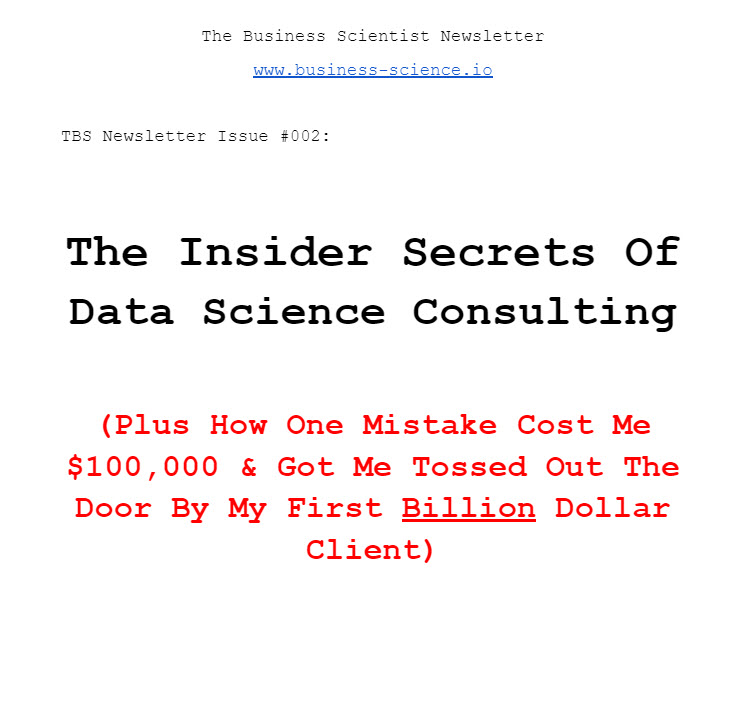
90% of data scientists struggle with business. Gain a business education FOR data scientists once per month straight to your inbox. The Business Scientist Newsletter (TBS) is free to join:
Usually Consultants blare their horns about how great it is to be a “one man show”.
The money is great!
You get to travel!
I can vacation whenever I want!
What they won’t tell you is the downside of being a consultant.
How they get themselves fired.
How they work tirelessly for weeks on end.
How clients can be a nightmare…
… Or How One Mistake Can Cost You $100,000
Well, I’m about to do all of that.
In 2018 I scored my first big consulting client on Linkedin.
They were an $8,000,000,000 per year company who shipped food to all major food suppliers.
I had a woman named Laura reach out to me to help her “bring data science to her business”.
She had just become a VP and was dead-set on making a splash to her upper executives. (At the time, data science still had the reputation of being “magic”.)
So we hopped on the phone, she cut me a check for $10,000 and off we went.
She wanted me to help her create a model which did a predictive analysis of her employees.
Now, I know you’re an intelligent human being… so you’re asking yourself “Wow! $10,000 to do predictive analysis. I wonder what we’re predicting?”
Well if you ever figure it out- let me know- because not only did I not know…
… she didn’t either!
And because she didn’t have a clear problem to solve, she left it up to “Let’s see what the data tells us”. (Whatever that means.)
Let Consulting Nightmare #1 Begin
Once we signed the contracts, I gave her a list of normal places to source data from. Because we were dealing with employees, they were mostly from HR.
A week goes by, no contact.
Two weeks go by and I reach out.
“Hey Laura, did you get any data yet?”
“Nope.”
It was the same story for the next week.
And the next week.
And the next week.
And the week after that.
And if you’re tired of reading about how many weeks, I’m tired of typing them.
But alas here we are talking about the week after that.
(you get it.)
Twelve weeks go by and finally! She hands me data on her employees at 4:00pm on a FRIDAY.
“Hey Matt, I have that meeting with the executives next Wednesday, so could you have this done by Monday?”
She had the gall to ask me to do 3 months worth of work in 3 days.
But instead of telling Laura that was impossible, I said “Okay, that should be fine.”
So I worked from Friday night to early Monday morning straight trying to get this project done.
By the end I had a 20 page report, ready to rock and roll.
I had all of the details about how I would be shifting this Fortune 500 firm into the world of predictive analytics.
All I could think about was how much I could do for them. And how profitable this relationship could be.
While this gig was going to net me a cool $10,000. My eyes were on how many more gigs I could help them on.
The number kept growing in my mind. Maybe $100,000? Nah, that’s too low.
What about $500,000?
Heck, maybe even $1,000,000+ from this one client.
I was anxious. And excited to see what they thought of our 20-page predictive analysis report. Everything hinged on this.
So we scheduled a presentation of findings for later that day.
I come to the meeting with my special report in hand, and Laura brings a bunch of directors with her to showcase how smart she was for hiring me.
The moment of truth was finally here. And my presentation began.
I started by explaining how we analyzed the data.
I then unboxed all of the algorithms we had used.
I inflected my voice as I got to the accuracy to help them feel how good this analysis was. (I thought this was super-risque)
And I presented how I could predict which employee was ready for a promotion (and the ones that weren’t).
All with metrics to back it up. “AUC”, “Confusion Matrix”, “Precision”, “Recall”…
…No data science metric was left unturned in my presentation.
At the end of the presentation, I couldn’t have been more excited. I asked them, “Any questions?”
I was sure they would have a ton.
So I saved extra time to handle and help them put my analysis into their presentation for the Executive Board.
But, there weren’t any questions.
The V.P. of Human Resources. She was silent.
The Director of Human Resources. She was silent too.
Something had went terribly wrong. I thought to myself, what did I do? Did I overlook something?
Did I not make it “predictive” enough?
Was there not enough metrics?
Well it turns out the whole project was doomed. Why?
They wanted something they could drop into their executive board presentation.
Not a hap-hazard cluster of “findings” with no direction.
I Was Thanked For My Time And Told They Would Reach Out For Phase 2 Of The Project. They Never Did.
I used to be bitter about that project but the bad times didn’t stop there.
Consulting Nightmare #2
A year later, I was deep into my consulting career.
I was juggling a job as a director at Bonney Forge, and then pulling in jobs by the boatload off of LinkedIn.
So Sam (a C-Suite Executive of a small tech company) approaches me to help him automate a couple of processes in his business.
We hop on the phone and he has an employee who is wasting 12 hours a week on a process he knows could be automated with a Shiny app.
He of course, asks me to build him one.
“Sam, I would love to build you a Shiny app. Can you show me exactly what you need automated?”
(See, I had learned by this point to ask clients EXACTLY what they wanted.)
“Sure Matt, I’d love to.”
What he shows me is a very low-level task that could easily be automated.
“Sam, how much are you paying this employee?”
“$30 an hour”
“So that’s… (30 x 12 = $360) 360 a week? So roughly 1,200-1,400 a month?”
“That’s right”
“Sam, you realize if you want me to build you a Shiny app for this, it’s going to cost fifty thousand dollars right?”
“Oh, well that’s fine.”
“Sam, what other problems do you have that could be automated? Anything like a $100,000 to $1,000,000 problem?”
“Yeah actually…”
See, if I had taken on that project, they would realize by the end of it, they were LOSING money on that deal and would either 1. Refund or 2. Never hire me for anything else.
We ended up making a deal helping him solve a HUGE problem with customers and he walked away a very happy customer.
The Business Science Problem Framework
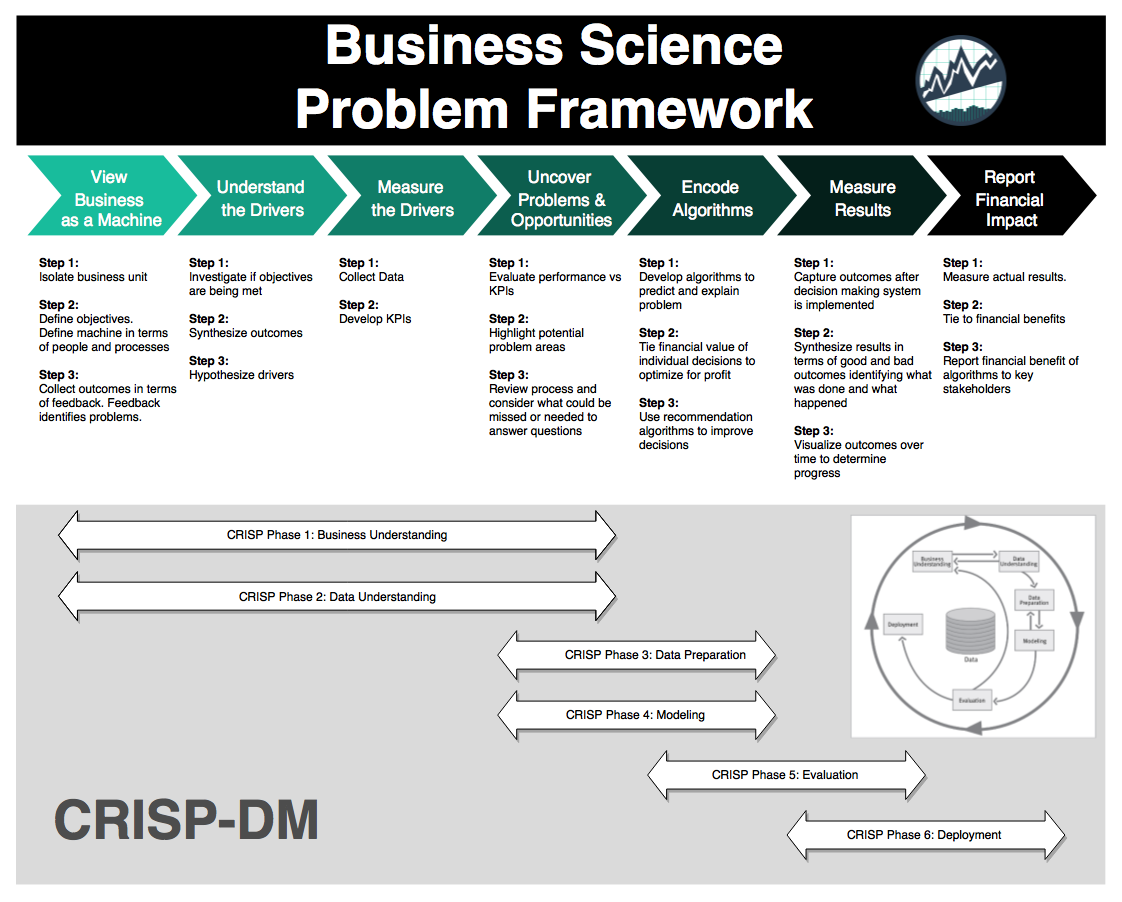
Fig. 1: The Business Science Problem Framework
This little framework was born from failure. But the impact it’s had on the data science world is profound.
Not only has the BSPF Framework helped me increase my consulting performance pulling in over $500,000+ in my second year of consulting with big companies, but…
My BSPF Framework has also helped over 100+ aspiring data scientists land data science jobs at big companies like Verizon, CitiBank, the Federal Reserve, Air Canada, BCG Gamma, Delloite, PwC, JP Morgan Chase, and more.
Will is a student of mine that landed his 6-figure data scientist job at Verizon. What’s among what’s helped? It’s none other than the BSPF Framework.
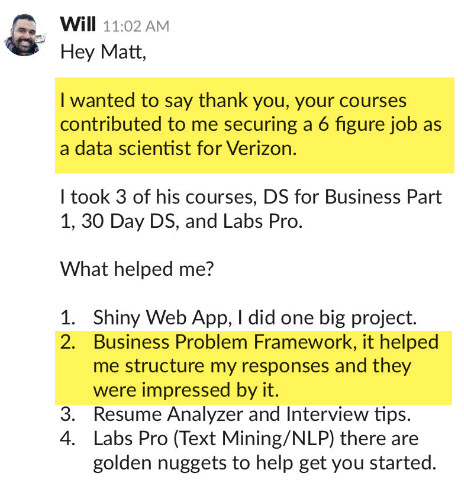
The BSPF Framework helped Will Land His 6-Figure Data Science Job At Verizon
Jennifer used the BSPF Framework to get an offer from JP Morgan Chase for her dream job, as V.P. of Strategic Analytics. She explained that the hiring manager “fast-tracked an offer.”
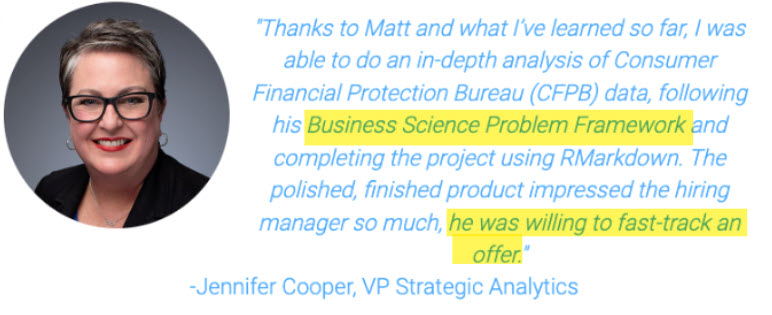
The BSPF Framework helped Jennifer Land Her 6-Figure Data Science Job At JP Morgan Chase
The amount of value that my students are providing to companies is unparalleled.
In fact, Auggie, a student of mine used the BSPF Framework to save his company $5,000,000 per year on 1 project. His company even recognized him in their investor call and promoted him to Senior Analytics Manager a month later.
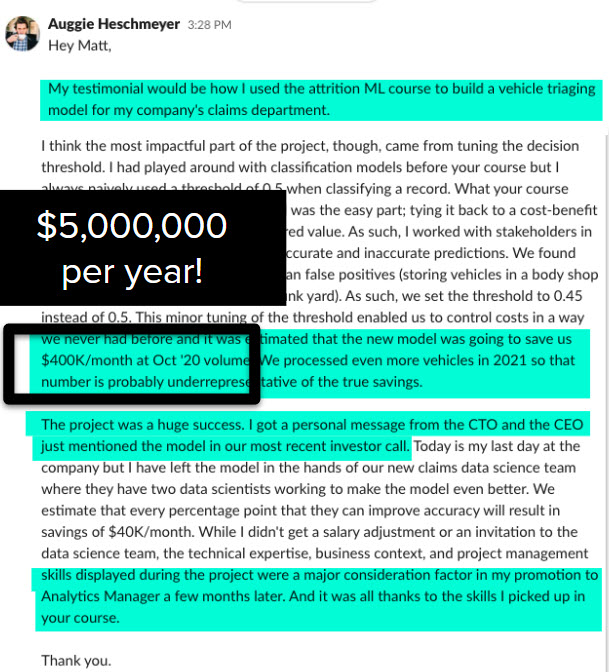
The BSPF Framework helped Auggie Save His Company $5,000,000 (and got him a promotion to Analytics Manager)
Now for the fun part…
Time For Data Science
I’m going to walk you through exactly how the BSPF Framework works. So you can use the BSPF to:
- Land a data science job.
- Save your company a ton of cash (and unleash multiple promotions).
- Create your own data science consulting side hustle (like I did)
Why The BSPF Works
The BSPF:
- Provided a clear plan that I could discuss with executives and align their interests with a return-on-investment (ROI) oriented framework.
- Exposed the key steps in a data science project in a way that exec’s understood
- Showed that it takes several weeks if not months to do a data science project right
- Helped bring client questions up front in early discussion, which we were able to answer and build into the project scope
- Gave the clients a sense of confidence that I knew what I was doing.
I began using the BSPF framework on every job. I saw client satisfaction skyrocket.
Another benefit was that I was able to increase my consulting rates since a 90 day action plan with the BSPF helped clients see the value of my process.
And this is what businesses want to see early on.
How The BSPF Works

Fig. 2: The 7-Stages of the BSPF Framework
There are 7 key stages to the BPSF:
- View The Business As A Machine
- Understand The Drivers
- Measure The Drivers
- Uncover Problems and Opportunities
- Encode Algorithms
- Measure Results
- Report Financial Impact
Pro-Tip: Think of each stage as a meeting or a milestone for the team. At the end of the stage, pull the team together. Make sure everyone is on the same page before you move onto the next stage. And always let them know what’s going to happen next.
Stage 1: View The Business As A Machine
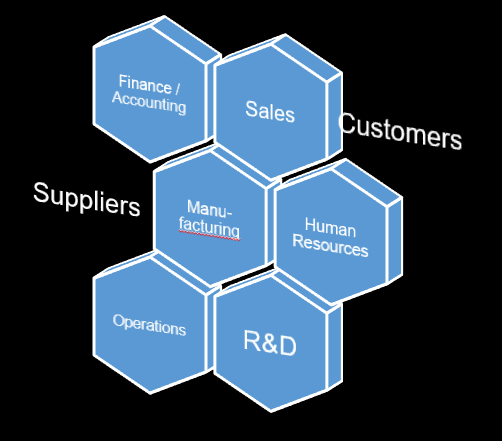
Fig. 3: Components Of The Machine
The first step is viewing the business as a machine. This involves:
- Isolating business units
- Defining objectives
- Collecting outcomes
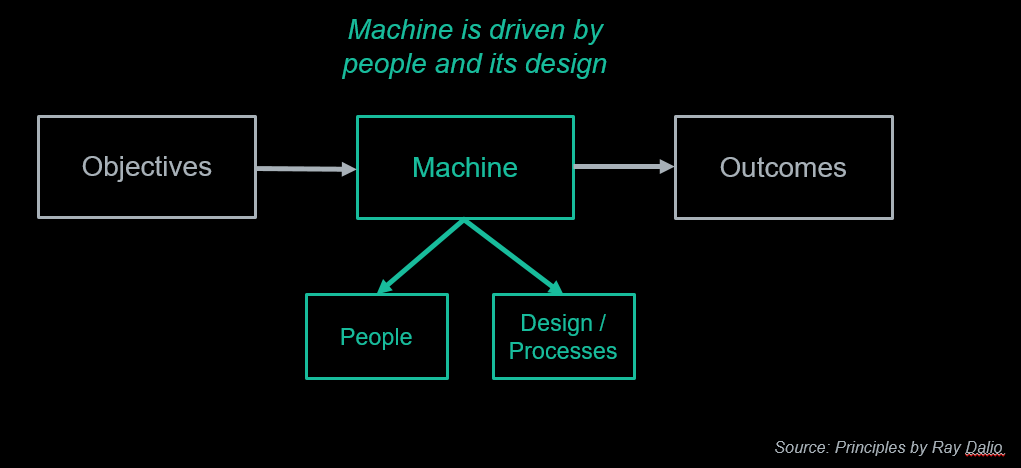
Fig. 4: Visualizing The Business As A Machine
Pro-Tip (Most Data Science Teams Skip This): A mistake that most data science teams make is they skip “sizing” the problem. In this stage, it’s important to understand the size of the problem (or how much it’s costing the company).
If the company is slowly losing customers, how is this impacting revenue? Is the problem a $100 problem, a $100,000 problem, or a $1,000,000 problem? If it’s less than $100,000, it may not be worth your time. Further, if it’s over $1,000,000, executives need to know this. Get them involved quickly.
Stage 2: Understand The Drivers

Fig. 5: Developing a hypothesis with Subject Matter Experts (SMEs)
The key steps are:
- Investigate if objectives are being met
- Synthesize outcomes
- Hypothesize drivers
Pro-Tip: A key in this stage is communication with Subject Matter Experts (SMEs). As a data scientist, we know the tools really well. But, tools are only useful when we understand the drivers and the business problem fully. We need to educate ourselves by listening to SMEs.
Don’t make the mistake of trying to understand the drivers yourself. Use SMEs to help. This generates “buy-in” from the organization when you include others that are experts in parts of the problem. The success of your project depends on this level of SME communication.
Stage 3: Measure Drivers

Fig. 6: Collecting Data From Internal and External Sources
The key steps are:
- Collect Data
- Develop KPIs
Pro-Tips:
- Collecting data takes time, but don’t let it stop you. It may require effort to set up processes to collect it, but developing strategic data sources becomes a competitive advantage over time.
- Notice that KPIs requires knowledge of customers and industry for supplier, inventory, and turnover metrics. Realize that a wealth of data is available outside of your organization. Learn where this data resides, and it becomes a tremendous asset.
Stage 4: Uncover Problems And Opportunities
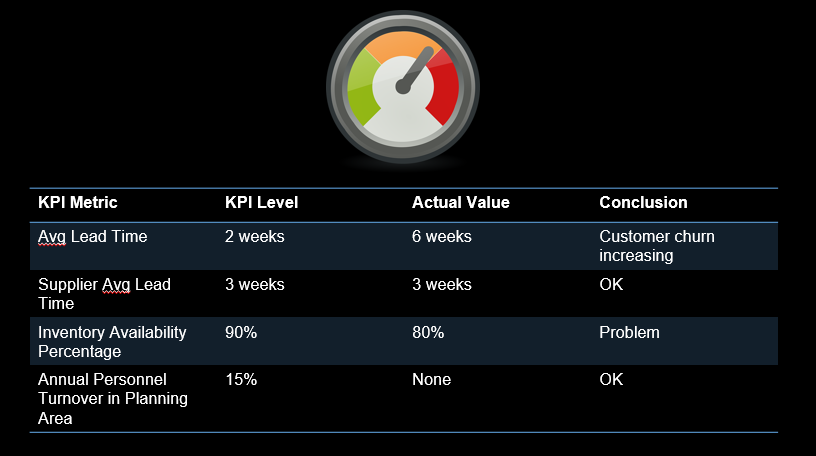
Fig. 7: Uncovering Problems In The Process With KPIs
Key Steps:
- Evaluate performance vs KPIs
- Highlight potential problem areas
- Review the our project for what could have been missed
Pro-Tip: Thomas Edison once said, “When you have exhausted all possibilities, remember this… you haven’t.” It’s common in Six Sigma to employ a reasoning technique called the 5 Why’s. Just ask why five times, and at that point you’ll usually get to the root cause of the problem.
Stage 5: Encode Decision-Making Algorithms

Fig. 8: Encoding Algorithms with H2O AutoML
Key Steps:
- Develop algorithms to predict and explain the problem
- Optimize decisions to maximize profit
- Use recommendation algorithms to improve decision making
Pro-Tip: Deployment of an automated business solution is what will really sell your business on your efforts. Using tools like R Shiny, you can create an application that others can use. Learn how to deploy applications like this one, and you become the linchpin: Unfirable. Essential. And the Go-To Expert for Data Science Projects.
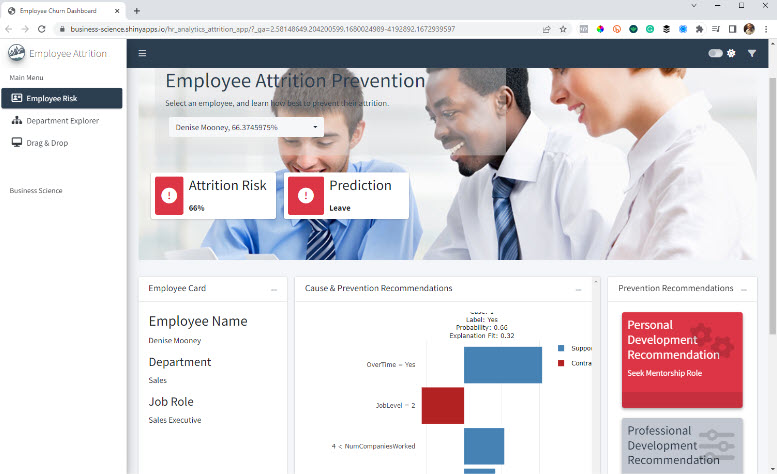
Fig. 9: Algorithm Deployment as a Shiny App Business Solution
Try the Shiny App Here
Stage 6: Measure The Results

Fig. 10: Visualizing the Project Results
Key Steps:
- Capture outcomes
- Synthesize results
- Visualize outcomes over time
Pro-Tip: Visualize the results over time. You should see impacts. Track and monitor these. And in the next step, calculate the savings.
Stage 7: Report Financial Impact

Fig. 11: Report Financial Impact (Return-On-Investment, ROI)
Key Steps:
- Measure actual results
- Tie to financial benefits (ROI)
- Report financial benefit (ROI) to key stakeholders
Pro-Tip: A common mistake is that data scientists don’t show the dollar-value $$$ associated with the solution. If you show a large savings of $5,000,000, then what do you think is going to happen to your career? Remember Auggie - He got promoted and recognized on the investor call. Reporting the financial impact was a key piece to his career acceleration.
In Closing, My 3 Career Pro-Tips:
Career Tip 1: In Your Next Job Interview…
Work the BPSF framework into your interview. Focus the interviewer on business value. This will absolutely set you apart from every other “run-of-the-mill” data scientist.
Career Tip 2: In Your First Big Project…
On the job, when you get that “first big project” that involves more than just you, dust off the BSPF Framework. Have it guide your project. Doing so could save the organization $5,000,000+ and solidify your next promotion.
Career Tip 3: When You Try Out Consulting…
If you ever get into business & data science consulting, revive the BPSF Framework. Put the BSPF Framework (or your own version of it) in your sales deck. Have it be part of your 90 day action plan. And use it as a selling tool. Chances are it will set you apart from other consultancies that just talk “big numbers” (but have no clue how to actually make the client money). This will give you and your client a path forward.
And, if you want to learn how to apply the BSPF Framework to an end-to-end data science project, I cover that in the second course in my 5-Course R-Track Program.
That’s a wrap. See you again on the 1st of next month.
The Greatest Data Science For Business Instructor in the World,
Matt Dancho
P.S. Next month I’m going to give you the inside scoop on how I built my first R package, tidyquant, to a powerhouse with 1,000,000 downloads (and it’s used at all the major financial companies).
P.P.S. AND, next month I’m going to show you how to get your own nightmare consulting clients. :)
This is how I can help:
-
Learn what’s ahead of you. Read my 155-page E-Book, “Everything You Should Already Know About Data Science”. I wrote this to uncover the mystery behind data science (and help people understand what businesses really want.)
-
Become a Business Data Scientist with my 5-Course R-Track. This program gets insane results like $100,000+ data science careers, +50% pay raises, Senior VP promotions, Lead Data Scientist (and more.) Don’t believe me? Check out my testimonials here. Want a taste of my program? Try my Jumpstart 2.0 - It’s the first week of my training program.
Want to find out what I did to solve more business problems with data science?
(and discover how to run circles around other data scientists, ethically steal promotions, raises and job titles from your more experienced coworkers, and make millions for your company in the process.)